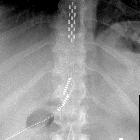spinal cord stimulator






Spinal cord stimulators, also known as dorsal column stimulators, are surgically placed devices to aid with symptom relief in individuals with chronic neurological pain (e.g. failed back syndrome, brachial plexopathy, complex regional pain syndrome).
It uses low voltage electrical current delivered by electrodes on the surface of the cord to prevent pain signal from reaching the brain. The underlying pathophysiology is not entirely understood, however, increase in levels of GABA and serotonin stimulated by an electrical pulse in the area of dorsal horns is one of the potential mechanisms .
Patients may feel a tingling sensation in the area of electrodes placement when the stimulator is on. Although it varies between individuals, generally it reduces pain sensation by ~60% .
Procedure
An internal pulse generator is implanted in the subcutaneous tissues of the flank, paraspinal, abdominal or upper gluteal regions with leads extending into the spinal canal with epidural electrodes placed adjacent to the dorsal columns. Two types of electrodes can be implanted :
- cylindrical: placed via percutaneous technique under fluoroscopy
- paddle: placed surgically via laminectomy or laminotomy
Complications
Complicated include :
- device-related, e.g. device malfunction, lead/electrode break or migration
- biological, e.g. infection, fluid collection or wound dehiscence, CSF leak, cord/nerve damage, epidural hematoma/abscess
Siehe auch:
und weiter:

 Assoziationen und Differentialdiagnosen zu Rückenmarkstimulation:
Assoziationen und Differentialdiagnosen zu Rückenmarkstimulation:


